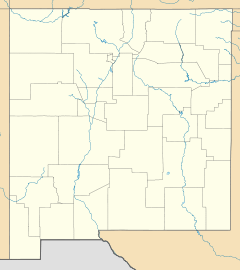- Hawikuh Ruins
-
Hawikuh
 Ruins of Mission La Purísima Concepción de Hawikuh, photo circa 1886
Ruins of Mission La Purísima Concepción de Hawikuh, photo circa 1886Location: Cibola County, New Mexico, USA Nearest city: Zuni, NM Coordinates: 34°55′56.0″N 108°59′4.4″W / 34.93222°N 108.984556°WCoordinates: 34°55′56.0″N 108°59′4.4″W / 34.93222°N 108.984556°W Built: circa 1400 Architect: Zuni Architectural style: Pueblo, Spanish Colonial Governing body: Private NRHP Reference#: 66000502 Significant dates Added to NRHP: October 15, 1966[1] Designated NHL: October 9, 1960[2] Hawikuh Ruins, or Hawikuh (Hawikku, "gum leaves" in Zuni [3]) is a National Historic Landmark located 12 miles southwest of Zuni Pueblo, New Mexico, on the Zuni Indian Reservation. It is included within Zuni-Cibola Complex, a larger National Historic Landmark District that includes other ruins as well.
Hawikuh was one of the largest of the Zuni pueblos at the time of the Spanish entrada. It was founded around 1400 AD.[3] It was the first pueblo to be visited and conquered by Spanish explorers.
Estevanico, a North African slave assigned to Fray Marcos de Niza's expedition, was the first non-native to visit Hawikuh, in 1539. He was killed when he unwittingly alarmed Zuni tribesmen with decorations that symbolized death.[3] [4]
Francisco Vásquez de Coronado conquered the pueblo in 1540, hoping it was one of the legendary "Seven Cities of Gold". He recorded its native name at the time as Cevola, though others who accompanied him wrote it as Cibola in their accounts. It has been conjectured that this name comes from a word meaning "buffalo". Coronado was severely disappointed by the lack of gold, but wrote that, "As far as I can tell, these Indians worship water, because it makes the corn grow and sustains their life." About the pueblo, he reported that, "Although they are not decorated with turquoises, nor made of lime or good bricks, nevertheless they are very good houses, with three, four, and five stories, where there are very good apartments... and some very good rooms underground [ Kivas], paved, which are made for winter and have something like hot baths." [5]
In 1628 the Mission La Purisima Concepcíón de Hawikuh was established. The Spanish attempted to suppress the Zuni religion, and introduced the encomienda forced-labor system. In 1632, the Hawikuh Zunis rebelled, burnt the church, and killed the priest. In 1672, the church was burnt again, by Apache raiders, and it was burnt a final time in 1680 during the Great Pueblo Revolt, when all the Nuevo Mexico pueblos rose against the Spanish. After this revolt, Hawikuh was permanently abandoned.[3]
The ruins of Hawikuh were excavated during the period 1917-23 by the Heye Foundation under the leadership of Frederick Webb Hodge. The records and artifacts from this excavation are now at the National Museum of the American Indian. [6] Hawikuh was declared a National Historic Landmark in 1961.[2][7]
Hawikuh is located on the Zuni Indian Reservation near Zuni, New Mexico.[7] The site may be visited with advance permission from the Zuni tribal office and a guide: 505-782-7022.
See also
Notes
- ^ "National Register Information System". National Register of Historic Places. National Park Service. 2007-01-23. http://nrhp.focus.nps.gov/natreg/docs/All_Data.html.
- ^ a b "Hawikuh". National Historic Landmark summary listing. National Park Service. http://tps.cr.nps.gov/nhl/detail.cfm?ResourceId=358&ResourceType=Site. Retrieved 2008-06-04.
- ^ a b c d Lanmon, Dwight P. and Harlow, Francis, "A brief history of the Ashiwi (Zuni) pueblos", in The pottery of Zuni Pueblo, 2008, Museum of New Mexico Press. ISBN 0890135088
- ^ Estevanico entry at the Handbook of Texas
- ^ Coronado's letter of August 3, 1540, quoted at [1]
- ^ Hawikuh at National Park Service
- ^ a b Marcia M. Greenlee (September 27, 1974). National Register of Historic Places Inventory-Nomination: Site of Hawikuh Pueblo (Zuni Indian Tribe) one of legendary Seven Cities, discovered by Estevanico in 1539PDF (32 KB). National Park Service and Accompanying 3 photos, from 1958PDF (32 KB)
External links
- Hawikuh Historic Site by the National Park Service
- Hawikuh by the Center for Desert Archeology
- The Battle of Hawikuh at Cibola
U.S. National Register of Historic Places Topics Lists by states Alabama • Alaska • Arizona • Arkansas • California • Colorado • Connecticut • Delaware • Florida • Georgia • Hawaii • Idaho • Illinois • Indiana • Iowa • Kansas • Kentucky • Louisiana • Maine • Maryland • Massachusetts • Michigan • Minnesota • Mississippi • Missouri • Montana • Nebraska • Nevada • New Hampshire • New Jersey • New Mexico • New York • North Carolina • North Dakota • Ohio • Oklahoma • Oregon • Pennsylvania • Rhode Island • South Carolina • South Dakota • Tennessee • Texas • Utah • Vermont • Virginia • Washington • West Virginia • Wisconsin • WyomingLists by territories Lists by associated states Other Categories:- Protected areas of Cibola County, New Mexico
- National Historic Landmarks in New Mexico
- Native American history
- Ruins in the United States
- Populated places established in the 13th century
- Former populated places in New Mexico
- History of Cibola County, New Mexico
- New Mexico geography stubs
- New Mexico Registered Historic Place stubs
Wikimedia Foundation. 2010.



